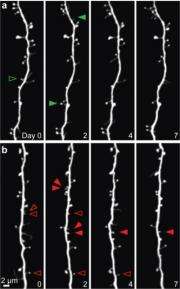Lifelong memories linked to stable nerve connections

Our ability to learn new information and adapt to changes in our daily environment, as well as to retain lifelong memories, appears to lie in the minute junctions where nerve cells communicate, according to a new study by NYU Langone Medicine Center researchers. The study is published online this week in the journal Nature.
The scientists, led by Wen-Biao Gan, PhD, associate professor of physiology and neuroscience at NYU School of Medicine, discovered that a delicate balancing act occurs in the brain where neuronal connections are continually being formed, eliminated, and maintained. This feat allows the brain to integrate new information without jeopardizing already established memories, the new study suggests.
Using a powerful optical imaging technique called two-photon microscopy, Dr. Gan and colleagues at The Helen and Martin Kimmel Center for Biology and Medicine at the Skirball Institute of Biomolecular Medicine, viewed the precise changes that take place at synapses, the junctions where nerve cells communicate, in the wake of learning a new task or being exposed to a novel situation. New knowledge, explains Dr. Gan, prompts alterations in the dendritic spines, the knobby protrusions along the branching ends of nerve cells. With learning, spines are gained and others lost.
"We've known for a long time that the brain remodels after learning," says Dr. Gan "Our studies show that the brain does this in two ways: by adding a tiny fraction of new connections to the brain's neural circuitry and eliminating old ones."
Dr. Gan and his associates tracked changes in the brains of mice before and after experiencing a new stimulus (a string of beads hung at different places along the cage) or learning a new task (running on an accelerated spinning wheel). To open a window to the brain, the team shaved away the skull over the animals' cortex in which the nerve dendrites were lit up by fluorescent proteins. Then, using a two-photon microscope, they snapped photos of the dendrites after the animals learned to stay on the running wheel or encountered the newly positioned beads. The team began photographing the mice when they were a month old and followed them through adulthood.
When the team compared the photos across the months, they observed new spines emerging in response to the beads' placement or learning to run on the wheel. They saw, too, that as the mice became improved at spinning the wheel, a minute fraction of new spines continued to persist. The researchers also noted that at the same time as these new and lasting spines were created, a corresponding number of older spines that had been formed early in the animals' development before the experiment began, disappeared.
Despite the rise and fall of dendritic spines, the animals' brain circuitry remained overwhelmingly secure. A mouse neuron can carry ten thousand spines on its dendrites. Over months, only tens of spines were either gained or lost on each nerve cell after exposure to new experience while the majority of existing spines are maintained.
The study gives a clue as to how it is possible for humans, who have hundreds of thousands of spines on one neuron, to live each day, constantly experiencing and learning new things, without losing existing memories. "The brain is a dynamic and stable organ," says Dr. Gan.
Source: New York University School of Medicine (news : web)


















